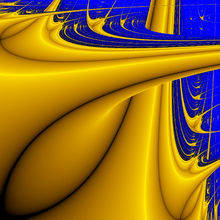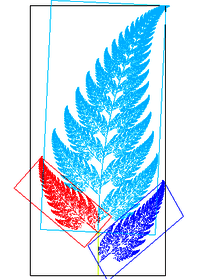Lyapunov fractal



In mathematics, Lyapunov fractals (also known as Markus–Lyapunov fractals) are bifurcational fractals derived from an extension of the logistic map in which the degree of the growth of the population, r, periodically switches between two values A and B.
A Lyapunov fractal is constructed by mapping the regions of stability and chaotic behaviour (measured using the Lyapunov exponent ) in the a−b plane for given periodic sequences of a and b. In the images, yellow corresponds to (stability), and blue corresponds to (chaos).
Properties
Lyapunov fractals are generally drawn for values of A and B in the interval . For larger values, the interval [0,1] is no longer stable, and the sequence is likely to be attracted by infinity, although convergent cycles of finite values continue to exist for some parameters. For all iteration sequences, the diagonal a = b is always the same as for the standard one parameter logistic function.
The sequence is usually started at the value 0.5, which is a critical point of the iterative function. The other (even complex valued) critical points of the iterative function during one entire round are those that pass through the value 0.5 in the first round. A convergent cycle must attract at least one critical point; therefore all convergent cycles can be obtained by just shifting the iteration sequence, and keeping the starting value 0.5. In practice, shifting this sequence leads to changes in the fractal, as some branches get covered by others; notice for instance how the Lyapunov fractal for the iteration sequence AB is not perfectly symmetric with respect to a and b.
Algorithm for generating Lyapunov fractals
An algorithm, for computing the fractal is summarized as follows.
- Choose a string of As and Bs of any nontrivial length (e.g., AABAB).
- Construct the sequence formed by successive terms in the string, repeated as many times as necessary.
- Choose a point .
- Define the function if , and if .
- Let , and compute the iterates .
- Compute the Lyapunov exponent:
In practice, is approximated by choosing a suitably large . - Color the point according to the value of obtained.
- Repeat steps (3–7) for each point in the image plane.
External links
- EFG's Fractals and Chaos – Lyapunov Exponents
- Elert, Glenn. "Lyapunov Space". The Chaos Hypertextbook.
